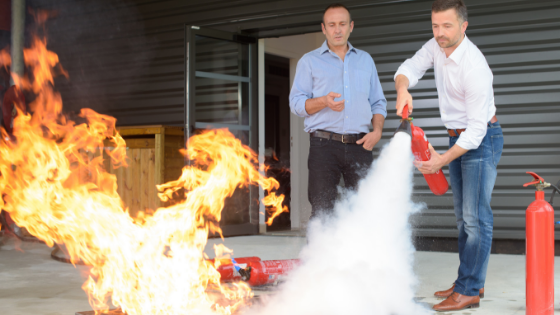Whether you work in a traditional office or a manufacturing setting, fire is always a safety threat. Keeping fire extinguishers on hand and teaching employees about fire exits are both critical components of workplace safety. However, not everyone realizes that there are different types of extinguishers that serve different purposes. It’s up to company managers and supervisors to make sure they have the right one.
This can be particularly important in manufacturing settings because different hazards may create the need to have different types of extinguishers available. The first step is determining what types of fire are most likely. It could be an electrical fire, a metallic fire, or a fire created from combustible solids or flammable substances. From there, you should be able to determine the type or types of extinguishers that are most appropriate. Let’s take a closer look at each type of fire extinguisher that could be needed in the workplace.
Wet Chemical Extinguishers
This is the type of extinguisher that is commonly found in kitchens. They can be used on fires that are fueled by cooking oils, as well as paper and wood. Inside the extinguisher is a solution of alkali salts mixed with water that creates a mist that puts out the flames and creates a soapy substance that helps to prevent the fire from reigniting.
Water Mist Extinguishers
The water mist types of extinguishers are among the newest types of fire extinguishers. They are valuable because of their versatility in being able to put out most types of fires. The water is released from the extinguisher is the form of fog, helping to reduce the oxygen around the fire so that it suffocates. At the same time, the water helps to cool the temperature and fight the fire on that front. Perhaps most importantly, water mist extinguishers use water that has had its minerals removed, which means it can be effective against electrical fires, which isn’t the case with most fire extinguishers.
Carbon Dioxide Extinguisher
A carbon dioxide extinguisher is among the types of extinguishers that are best to use against electrical fires. Of course, it’s also effective against fires caused by flammable liquids. As the name implies, this extinguisher gets rid of CO2, which takes the oxygen away from the fire. The best part is that it leaves no residue and won’t cause any short circuits or damage to electrical equipment. They won’t leave a giant mess to clean up afterward and can be useful in confined spaces. However, carbon dioxide extinguishers are sometimes only a temporary solution because they don’t do anything to prevent a fire from reigniting.
Foam Extinguisher
Foam extinguishers are typically ideal for liquid, gas, and wood fires. Needless to say, they spray a foam substance that expands and helps cover the fire like a blanket. The foam is mixed with water, helping to cool the fire while also taking away its fuel source. On occasion, they can be effective against electrical fires, although there are no guarantees. Of course, the downside with the foam types of extinguishers is they leave behind a residue that creates a big mess to be cleaned up once the fire is put out.
Always Stay Safe
Outside of figuring out the best types of extinguishers for your workplace, there is so much that goes into keeping your employees safe. The best thing we can recommend is a safety management system that keeps every aspect of safety organized. Our system will help you to track incidents, hazards, inspections, and safety training. In the long run, it will help any business save both time and money while also creating a safer work environment for employees.
If you could use a little extra help when it comes to safety, get in touch with us and we’ll let you know how we can help.
